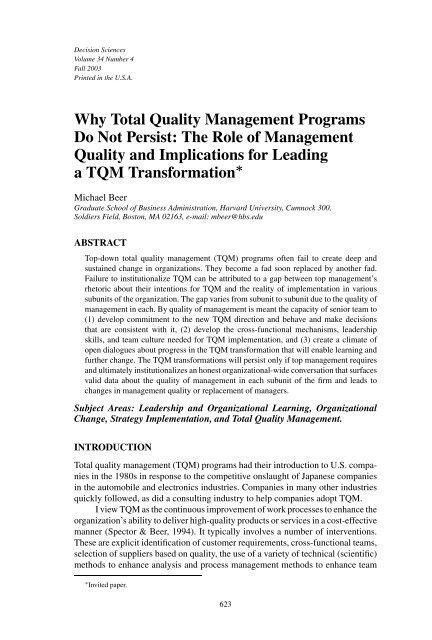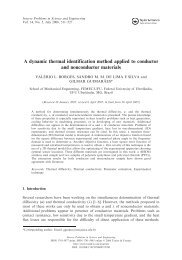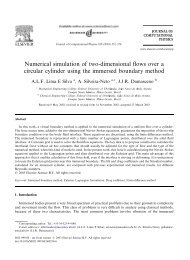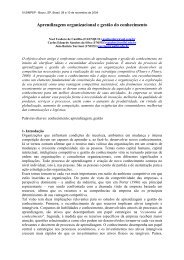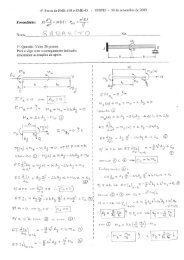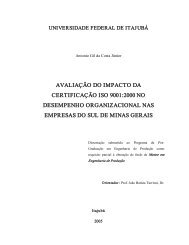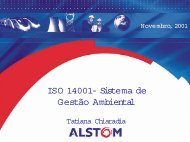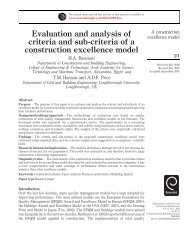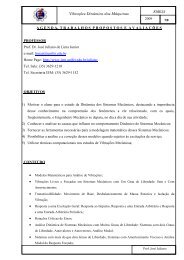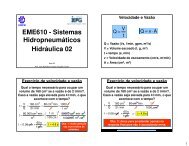Why Total Quality Management Programs Do Not Persist: The ... - IEM
Why Total Quality Management Programs Do Not Persist: The ... - IEM
Why Total Quality Management Programs Do Not Persist: The ... - IEM
You also want an ePaper? Increase the reach of your titles
YUMPU automatically turns print PDFs into web optimized ePapers that Google loves.
Decision Sciences<br />
Volume 34 Number 4<br />
Fall 2003<br />
Printed in the U.S.A.<br />
<strong>Why</strong> <strong>Total</strong> <strong>Quality</strong> <strong>Management</strong> <strong>Programs</strong><br />
<strong>Do</strong> <strong>Not</strong> <strong>Persist</strong>: <strong>The</strong> Role of <strong>Management</strong><br />
<strong>Quality</strong> and Implications for Leading<br />
a TQM Transformation ∗<br />
Michael Beer<br />
Graduate School of Business Administration, Harvard University, Cumnock 300,<br />
Soldiers Field, Boston, MA 02163, e-mail: mbeer@hbs.edu<br />
ABSTRACT<br />
Top-down total quality management (TQM) programs often fail to create deep and<br />
sustained change in organizations. <strong>The</strong>y become a fad soon replaced by another fad.<br />
Failure to institutionalize TQM can be attributed to a gap between top management’s<br />
rhetoric about their intentions for TQM and the reality of implementation in various<br />
subunits of the organization. <strong>The</strong> gap varies from subunit to subunit due to the quality of<br />
management in each. By quality of management is meant the capacity of senior team to<br />
(1) develop commitment to the new TQM direction and behave and make decisions<br />
that are consistent with it, (2) develop the cross-functional mechanisms, leadership<br />
skills, and team culture needed for TQM implementation, and (3) create a climate of<br />
open dialogues about progress in the TQM transformation that will enable learning and<br />
further change. <strong>The</strong> TQM transformations will persist only if top management requires<br />
and ultimately institutionalizes an honest organizational-wide conversation that surfaces<br />
valid data about the quality of management in each subunit of the firm and leads to<br />
changes in management quality or replacement of managers.<br />
Subject Areas: Leadership and Organizational Learning, Organizational<br />
Change, Strategy Implementation, and <strong>Total</strong> <strong>Quality</strong> <strong>Management</strong>.<br />
INTRODUCTION<br />
<strong>Total</strong> quality management (TQM) programs had their introduction to U.S. companies<br />
in the 1980s in response to the competitive onslaught of Japanese companies<br />
in the automobile and electronics industries. Companies in many other industries<br />
quickly followed, as did a consulting industry to help companies adopt TQM.<br />
I view TQM as the continuous improvement of work processes to enhance the<br />
organization’s ability to deliver high-quality products or services in a cost-effective<br />
manner (Spector & Beer, 1994). It typically involves a number of interventions.<br />
<strong>The</strong>se are explicit identification of customer requirements, cross-functional teams,<br />
selection of suppliers based on quality, the use of a variety of technical (scientific)<br />
methods to enhance analysis and process management methods to enhance team<br />
∗ Invited paper.<br />
623
624 <strong>Why</strong> <strong>Total</strong> <strong>Quality</strong> <strong>Management</strong> <strong>Programs</strong> <strong>Do</strong> <strong>Not</strong> <strong>Persist</strong><br />
effectiveness (Hackman & Wageman, 1995). <strong>Total</strong> quality management also involves<br />
a multiple-stakeholder philosophy that equally values community, customers,<br />
and employees. Implicit in this philosophy are values of teamwork and<br />
collaboration.<br />
<strong>The</strong>re is little question that when implemented properly, TQM can have<br />
a dramatic impact on the performance and culture of an organization (Deming,<br />
1986; Juran, 1989; Buzzell & Gale, 1987; Hackman & Wageman, 1995; Lawler,<br />
Mohrman, & Ledford, 1998). Two recent large-sample studies confirm these assessments.<br />
By comparing the performance of firms who have received quality awards<br />
with a matched control group of firms who have not, Hendricks and Singhal (1997)<br />
have shown that firms receiving quality awards outperform the control group in<br />
operating income and revenues over a ten-year period. In a second study Hendricks<br />
and Singhal (2001) showed that the long-run stock performance of firms who receive<br />
quality awards is far higher (38% to 46%) than a matched control group<br />
of companies who did not receive such an award. <strong>The</strong>se stock performance improvements<br />
are found in the five-year postimplementation period, not in the first<br />
five-year implementation period.<br />
<strong>The</strong> fact that improvement in the stock performance only occurred after five<br />
years of implementation, suggests that a TQM transformation is a long-term process<br />
requiring a fundamental shift in management practice and culture. This may explain<br />
why there have also been a plethora of studies questioning the value of TQM,<br />
many by consulting firms who work with their clients to implement TQM (see, for<br />
example, the International <strong>Quality</strong> Study, a joint study by Ernst and Young and the<br />
American <strong>Quality</strong> Foundation [1992] and Kelly [1992], who presents studies done<br />
by Arthur D. Little Inc. and Rath and Strong). According to these studies, senior<br />
management in some 60 to 70% of firms feel that quality improvement efforts have<br />
not boosted their capacity to compete, have not resulted in implementation of a<br />
significant number of practices associated with TQM, and have not focused TQM<br />
improvement on improved products and services.<br />
In this article I postulate that failures of TQM to persist are failures in implementation,<br />
not TQM theory and method. Failures occur because senior management<br />
tends to motivate change through top-down programs (Beer et al., 1990a; Schaffer,<br />
1988). Failure to solicit and receive feedback about potential gaps between their<br />
TQM rhetoric and the reality of implementation (Zbaracki, 1998) prevents senior<br />
management from learning how their own actions and policies may be responsible<br />
for the gap and then making changes accordingly. Top-down programs also undermine<br />
unit leaders’ commitment and their capacity to lead a TQM transformation<br />
in their unit.<br />
I will argue that it is the capacity of management to inquire into the inevitable<br />
gap between the TQM program they advocate (their rhetoric) and the reality of<br />
actual practice that ultimately determines the effectiveness of a TQM corporate<br />
transformation. Paradoxically, it is management’s lack of capacity to explore these<br />
gaps, the very process of inquiry, analysis, and action embedded in TQM that<br />
causes TQM implementation failures. Such high-quality management is what I<br />
argue is needed if TQM initiatives are to persist. Empirical evidence from an action<br />
research program aimed at helping senior management learn about gaps between<br />
their espoused strategy and the perceptions of its implementation at lower levels will
Beer 625<br />
be used to specify the management qualities needed to implement a TQM strategy<br />
and a process. <strong>The</strong> missing ingredient in unsuccessful TQM transformations, I will<br />
argue, is a total quality management process for assessing and developing a high<br />
quality of management at every level. A set of principles for such a management<br />
and leadership improvement process will be offered as well as empirical evidence<br />
about their efficacy.<br />
WHY TQM PROGRAMS FAIL: IT’S NOT THE SEED,<br />
IT’S THE SOIL THAT MATTERS<br />
An underlying, often-unstated, requirement for TQM interventions to take root<br />
is a fundamental transformation of the organization’s culture (Schein, 1992). Organizations<br />
must unhook themselves from their functional moorings by delegating<br />
authority to lower-level cross-functional teams who have decision rights to<br />
implement process changes using the technical methods of TQM (Hackman &<br />
Wageman, 1995; Spector & Beer, 1994). In almost all cases this means functional<br />
managers will lose power, and process team leaders and members will gain<br />
power. For these changes to occur, the basis of power must shift from authority<br />
based on position to authority based on knowledge and proximity to problems and<br />
information.<br />
For long-term success the organization may also have to consider how financial<br />
gains from improvements are going to be allocated so that employee commitment<br />
can be sustained (Hackman & Wageman, 1995). Finally, management’s<br />
behavior and the organization’s emergent culture must become consistent over<br />
time with the TQM philosophy or employees will become cynical. Such cynicism<br />
in turn undermines commitment. Thus a company seeking to make a fundamental<br />
TQM transformation faces significant organizational and managerial change<br />
challenges.<br />
It is highly likely the difficulty in TQM implementation reported by consultants<br />
(see earlier) reflects the programmatic nature of their interventions. Consultants<br />
recommend the adoption of cross-functional teams and extensive training<br />
in TQM philosophy and methods, for example, but unless senior teams at every<br />
level of the company are committed to the ideas, they will not realign their own<br />
behavior and the organization’s policies and practices to support this new direction.<br />
Without that support managers experience a gap between rhetoric and reality,<br />
become cynical and underinvest their time and energy in managing the transformation<br />
in their unit. As top managers come to realize that top-down programs are<br />
not working, they reduce their commitment and withdraw resources (their time<br />
and money). As a result TQM becomes a passing fad until the next program is<br />
introduced.<br />
<strong>The</strong> proposition that TQM is often seen as a fad and not adopted with the<br />
deep commitment needed for successful implementation is supported by research.<br />
Miller and Hartwick (2002) found that TQM citations in the business literature<br />
began a continuous long-term decline in 1992 after a decade of dramatic increases.<br />
During the same period there was also a marked decline in TQM consulting firms.<br />
Further supporting the conclusion that many TQM initiatives are seen as fads
626 <strong>Why</strong> <strong>Total</strong> <strong>Quality</strong> <strong>Management</strong> <strong>Programs</strong> <strong>Do</strong> <strong>Not</strong> <strong>Persist</strong><br />
like other best practices, Miller and Hartwick found that the decline in TQM<br />
citation was followed by a rise and subsequent decline in business process reengineering<br />
(BPE) citations. Commitment to TQM appears to have been only skin<br />
deep.<br />
<strong>The</strong>se findings are also supported by research about organizational change,<br />
which finds that top-down programs, including TQM, do not lead to fundamental<br />
and persistent corporate transformations (Beer, Eisenstat, & Spector, 1990; Beer,<br />
Spector, & Eisenstat, 1990; Schaffer, 1988). <strong>The</strong> superficiality that characterizes<br />
all too many top-down programs is captured by the following observation of a<br />
manager whose company had launched a quality program:<br />
<strong>The</strong> first quality circle program was very political; everybody noticed who<br />
participated and who didn’t. Any problems we had in implementing it had to<br />
be swept under the rug. All management wanted to know was how many teams<br />
had been formed and how much money they had saved. (Beer et al., 1990b,<br />
p. 33)<br />
<strong>The</strong> result in this company was cynicism by employees who saw inconsistencies<br />
between management’s espoused new TQM direction and the reality of<br />
superficial change. “This too will pass,” was one of the most frequent responses<br />
to new programs, an indication of low commitment, an essential ingredient for<br />
fundamental change. Indeed, ten years later the company from which the above<br />
quote came was no longer in existence, a casualty of competition. Spurred by General<br />
Electric’s reported success with Six Sigma total management quality program<br />
under Jack Welch, a high-status CEO, we are now seeing a resurgence of total<br />
quality management initiatives in many companies under this new label. <strong>The</strong>re is<br />
no reason to believe, however, that the implementation of Six Sigma programs in<br />
many companies will be any more successful than the programs in earlier years.<br />
Innovations like TQM are typically motivated by top management’s desire<br />
to improve performance. However, if top management adopts TQM because other<br />
firms have, the understanding of TQM and how it can be used to improve performance<br />
of the firm will be low. If understanding is low, commitment will also be<br />
low and will lead to early abandonment. <strong>The</strong>re is considerable evidence that many<br />
firms adopt innovations in management in the hope of rapid painless change as<br />
well as legitimacy in the eyes of investors and the business community (DiMaggio<br />
& Powell, 1983; Staw & Epstein, 2000; Westphal, Gulati, & Shortell, 1997). From<br />
a change perspective, the adoption of TQM because other high-status companies<br />
have is problematic. Chief executive officers who do so are not likely to be responding<br />
to problems defined by a rigorous analysis of barriers to higher performance in<br />
their own company. As a result they are unlikely to be launching change with real<br />
conviction. This causes these CEOs to delegate the TQM change to a staff group,<br />
increasing cynicism as rhetoric and reality diverge over time. In these companies<br />
TQM is measured by the number of quality teams and people involved in them,<br />
as the quote above suggests, as opposed to an honest assessment of how widely<br />
and effectively the company and its local unit leaders are making TQM an integral<br />
part of their organizational unit’s practice and culture. Delegating change to a staff<br />
group who launches a program on behalf of the CEO leads to compliance by line<br />
managers—they respond to the political pressures described by the manager in
Beer 627<br />
the earlier quote—as opposed to being internally committed. It is not surprising,<br />
therefore, that TQM initiatives managed in this manner fail to be sustained.<br />
Once a TQM program is launched, it is highly unlikely that management<br />
will hear the honest truth about gaps between their rhetoric and the reality of<br />
implementation. Extensive research shows the tendency of lower levels to hide<br />
painful truths from senior management (Argyris, 1990; Beer & Eisenstat, 2000;<br />
Morrison & Milliken, 2000). Zbaracki (1988) found that the reality of TQM implementation<br />
in five firms he studied diverged significantly from the rhetoric of top<br />
management. Money was spent on various programs but managers and workers often<br />
felt that it was wasted. In these companies TQM successes are more likely to be<br />
reported to top management than difficulties in implementation or complete failures<br />
(Zbaracki, 1998; Mallinger, 1993). <strong>Programs</strong> are also likely to result in compliant<br />
subunit managers. Because they are passive participants in the TQM program, they<br />
will not have developed real understanding and commitment to TQM, are unlikely<br />
to have the will to lead change in their unit or to solicit and receive honest feedback<br />
from their people about gaps between their aspirations for TQM and reality.<br />
Given this research evidence, I postulate that failure to implement a sustained<br />
TQM transformation is a function of deficiencies in the following fundamental<br />
managerial capabilities:<br />
Proposition 1 <strong>The</strong> capacity of senior teams at the corporate and unit level to<br />
develop commitment to TQM through an effective dialogue about why the company<br />
should adopt TQM and agreement about what must be done to implement it.<br />
Proposition 2 <strong>The</strong> capacity of the senior team to follow up their initial commitment<br />
with changes in organizational arrangements (a cross-functional team-based<br />
organization) and behavior (their own and that of subunit leaders) needed to support<br />
their TQM intentions.<br />
Proposition 3 <strong>The</strong> capacity of the senior team to create an honest organizationwide<br />
conversation about the effectiveness of TQM implementation from which<br />
they can learn about the quality of their management and leadership in moving<br />
change along.<br />
Proposition 4 <strong>The</strong> managerial capabilities above must exist in all subunits of the<br />
corporation for successful TQM transformation to take place.<br />
<strong>The</strong>se managerial capabilities constitute the “fertile managerial soil” essential<br />
for the “TQM seed” to take root, grow, and become part of the organization’s<br />
fabric. <strong>The</strong> requirement that these capabilities exist at multiple levels of<br />
the corporation is supported by research. In a seminal study, Fleishman, Harris,<br />
and Burtt (1955) found that changes in supervisory attitudes about how to manage<br />
people after training were not sustained unless the supervisor’s manager possessed<br />
similar attitudes. Edmondson and Woolley (2003) found that new managerial<br />
skills introduced through corporate training programs took root in those subunits<br />
whose leaders had the skill and will to embrace these new managerial behaviors<br />
(I am indebted to them for first framing organizational interventions as seed and<br />
soil).
628 <strong>Why</strong> <strong>Total</strong> <strong>Quality</strong> <strong>Management</strong> <strong>Programs</strong> <strong>Do</strong> <strong>Not</strong> <strong>Persist</strong><br />
My own research on strategy implementation, though not focused on TQM<br />
strategies per se, provides empirical support for the propositions above. <strong>The</strong>se<br />
findings are reviewed next.<br />
THE SILENT KILLERS: UNDISCUSSIBLE MANAGEMENT<br />
BARRIERS TO STRATEGY IMPLEMENTATION<br />
For over a decade Russell Eisenstat and I have been conducting an action research<br />
program that reveals why a gap exists between senior management’s stated strategy<br />
and the capacity of the organization to implement it. Using an intervention<br />
called Organizational Fitness Profiling (OFP), designed to help senior teams inquire<br />
into the quality of their direction and the organization’s capacity to implement<br />
it as perceived by lower levels, we found, like Zbaracki (1998) who studied TQM<br />
programs, that employees perceive a gap between rhetoric and reality. Because<br />
OFP enabled lower levels to speak truthfully to senior teams about the causes of<br />
the gap, we were able to identify six core managerial barriers (Beer & Eisenstat,<br />
2000). We call them “silent killers” because, like cholesterol and hypertension,<br />
the silent causes of heart attacks, no one can talk openly about them (Morrison &<br />
Milliken, 2000). Because I will later argue that an inquiry process like OFP will<br />
be necessary to overcome the poor leadership and management that blocks a TQM<br />
transformation, I first describe the process briefly.<br />
<strong>The</strong> OFP process begins with the senior management team developing a<br />
one- to two-page statement of business and organizational direction that advocates<br />
their strategic intent—what the organization must do to succeed in achieving its<br />
objectives and what types of values and organizational capabilities they believe the<br />
organization needs to implement its strategic intent. <strong>The</strong> senior team then appoints<br />
a task force of 8 of their best people to interview 100 other key people from all<br />
parts of the organization one to two levels below the top team. Task force members<br />
conduct open-ended interviews under ground rules of complete confidentiality<br />
with the understanding that the top team will hear the unvarnished truth about<br />
strengths and barriers to implementation. <strong>The</strong>se interviews often turn out to be<br />
very emotional. In many organizations it is the first time lower levels have been<br />
asked to tell the truth to their leaders. Task force members also display emotions.<br />
<strong>The</strong>y are very anxious about feeding back their findings to the senior team and<br />
exhilarated about the opportunity they have been given to play a role in improving<br />
the organization’s effectiveness.<br />
<strong>The</strong> release of previously hidden data is made possible by the fact that<br />
management has committed itself publicly to hear the unvarnished truth and to<br />
make itself accountable to lower levels for doing something about what they<br />
learn. <strong>The</strong> “public” nature of the organizational conversation, in the context<br />
of a process that credibly enables truth to speak to power safely, is the key<br />
to breaking silence, changing norms of silence, and motivating management to<br />
act.<br />
A content analysis of the data from a dozen different organizations, subsequently<br />
validated through findings in many other organizations, has revealed that<br />
task forces almost always report the following six barriers as a group:
Beer 629<br />
1. Unclear strategy and conflicting priorities<br />
2. Leadership style of general manager—too top-down or too laissez faire<br />
3. An ineffective top team<br />
4. Poor coordination<br />
5. Inadequate down-the-line leadership or management skills and development<br />
6. Closed vertical communication (top-down and bottoms up).<br />
<strong>The</strong>re are few hierarchical organizations that do not display this syndrome of<br />
managerial barriers to some extent. <strong>The</strong> barriers represent the inevitable problems<br />
senior teams face in developing agreement about their strategic intent, designing<br />
the organization to achieve requisite coordination, and then learning the truth<br />
about how organizational behavior and their leadership may be blocking effective<br />
implementation. Figure 1 illustrates how the six barriers contribute to poor quality<br />
of direction, poor implementation, and poor learning about the gap between<br />
managerial intent and organizational action. <strong>The</strong>se barriers prevented effective implementation<br />
of various strategies in the organizations we studied. Below I discuss<br />
how these six barriers probably interact to prevent successful implementation of a<br />
TQM strategy.<br />
Effective implementation of any managerial intent, including TQM, must start<br />
with quality of direction. That quality depends on an effective senior team—one that<br />
has developed real agreement about and commitment to objectives, strategy, and<br />
priorities. Without that commitment a strategic change like TQM cannot succeed.<br />
Figure 1: Undiscussible dynamics of poor management quality.
630 <strong>Why</strong> <strong>Total</strong> <strong>Quality</strong> <strong>Management</strong> <strong>Programs</strong> <strong>Do</strong> <strong>Not</strong> <strong>Persist</strong><br />
Senior management would not be speaking or acting with one voice—something<br />
that is reflected in the barrier of conflicting priorities that lower levels often see.<br />
Given the tendency of corporate leaders to adopt TQM because other successful<br />
companies have, it is not hard to imagine that many TQM programs start with a<br />
lack of real understanding and emotional commitment by top management. <strong>The</strong>ir<br />
lack of emotional commitment can easily lead them to rely on staff groups or<br />
consultants to drive the TQM program, as suggested earlier. This in turn leads<br />
leadership teams at the subunit level to passively comply with the corporate TQM<br />
program for political reasons rather than out of conviction that TQM will improve<br />
their unit’s performance.<br />
An ineffective senior team, one that cannot confront issues constructively,<br />
is also unlikely to develop empowered cross-functional TQM teams because they<br />
threaten the authority of functional managers on the senior team. It is not surprising,<br />
therefore, that the quality of strategy implementation (see Figure 1) in organizations<br />
with ineffective senior teams was perceived to be blocked by poor coordination<br />
between key activities along the value chain. <strong>The</strong>se senior teams were incapable of<br />
confronting the power issues that need to be negotiated to create a cross-functional<br />
organization. Even if these teams were to be created, they require team leaders<br />
with the authority and skill to lead them (Spector & Beer, 1994). <strong>The</strong> inadequate<br />
number of down-the-line leaders typically perceived by employees as a core barrier<br />
to implementing strategies like TQM is also a function of an ineffective senior<br />
team. Ineffective top teams typically have not resolved their different values and<br />
assumptions about what constitutes quality management nor do they cooperate<br />
to facilitate cross-functional career moves that are so important for developing<br />
managers with the general management perspective and skills needed to lead crossfunctional<br />
teams.<br />
<strong>The</strong> sixth barrier to strategy implementation identified in all the organizations<br />
we studied was closed vertical communication. As Figure 1 shows, poor vertical<br />
communication, caused by fear and norms of silence, reduces the organization’s<br />
quality of learning. Senior managers are not confronted with managerial and organizational<br />
barriers that prevent the TQM transformation they espouse. <strong>The</strong>y are,<br />
therefore, prevented from making the midcourse corrections essential in leading a<br />
TQM transformation. Our findings that fear of speaking up blocked senior teams<br />
from learning about strategy implementation problems help explain the gap between<br />
rhetoric and reality found by Zbaracki (1998) in organizations undertaking a<br />
TQM initiative. Without honest vertical communication the senior team cannot discover<br />
the leadership and management problems that are blocking use of “technical<br />
methods” like statistical process control.<br />
<strong>The</strong> case of Sigtek, a subsidiary of Telwork, illustrates how TQM initiatives<br />
driven by corporate staff groups falter due to the six silent managerial killers<br />
(Jick & Rosegrant, 1990). To comply with Telwork’s corporate mandate to implement<br />
TQM, a divided and ineffective senior team led by a laissez faire and<br />
conflict-averse president at Sigtek appointed two of its key people as site trainers<br />
and change agents. After an expensive TQM training program workers discovered<br />
that they were prevented from solving recurring quality problems due to a<br />
deep and politicized divide between the engineering and operations function (poor
Beer 631<br />
coordination). Workers and trainers became cynical about TQM. Due to norms<br />
of silence, they did not, however, provide honest feedback (vertical communication<br />
barrier) to the senior management team about the increasing gap between<br />
the rhetoric of the training program and reality. To do so would have exposed<br />
Sigtek’s ineffective leader, senior team, and organization (the six silent killers).<br />
Telwork’s top management was also kept from understanding the failure at Sigtek<br />
until very late in the process because they relied on a top-down staff-driven training<br />
program that ignored the quality of leadership and management at Sigtek.<br />
By then loss of hope by workers and managers had eroded the commitment to<br />
TQM and made implementation virtually impossible. Though Telwork eventually<br />
removed Sigtek’s president, a lot of time and money had been wasted. Moreover,<br />
cynicism would make it more difficult to begin a new initiative. Consider the reactions<br />
of an employee to a similar top-down TQM program in a government<br />
agency:<br />
If you vocalize and you beat the drum and you talk about total quality to a<br />
mass of people who aren’t going to see it, who aren’t going to be involved in it,<br />
they get a tin ear. It sounds wrong. People say “what are they doing? <strong>Why</strong> are<br />
they waiting? We don’t see anything. <strong>The</strong>y are wasting all that money doing<br />
all these things, but we don’t see anything.” (Zbaracki, 1998, p. 619)<br />
In launching the TQM program corporate top management at Telwork acted<br />
as if TQM was about technical methods for continuous improvement despite the<br />
fact that its rhetoric imparted a philosophy that valued employee “participation,<br />
leadership, and fearlessness in approaching the job.” A successful TQM transformation<br />
required the very quality of management they espoused but which did<br />
not exist in many of the company’s newly acquired subsidiaries. To embed TQM<br />
practices in all of its subsidiaries (the seed), Telwork’s top management needed a<br />
means to assess and develop that quality of management (soil).<br />
Failed TQM programs inoculate the organization against learning and change<br />
in the future. Each successive change initiative is suspected as another “flavor of<br />
the month,” explaining the finding, discussed earlier, that TQM in the 1980s was<br />
a passing fad. Employees comply but do not make an emotional commitment.<br />
Ironically, the fact that employees cannot confront senior management with the<br />
truth belies the very continuous improvement culture TQM leaders espouse as<br />
essential for improved performance.<br />
<strong>The</strong> six silent killers of strategy implementation are quite consistent with<br />
the three propositions about organizational capabilities proposed in the previous<br />
section. In only one of the cases in the sample of companies we analyzed was total<br />
quality management an explicit objective of management, however. <strong>The</strong>refore,<br />
more research in organizations undergoing a TQM transformation is needed to<br />
determine if these propositions apply to the implementation of a TQM strategy.<br />
Such research might compare companies who have received quality awards and<br />
outperformed in the out years to companies that have not received such an award<br />
for the management capabilities embodied in the four propositions. Given the<br />
emphasis of quality awards on leadership and communication, it is likely that the<br />
four propositions would be confirmed.
632 <strong>Why</strong> <strong>Total</strong> <strong>Quality</strong> <strong>Management</strong> <strong>Programs</strong> <strong>Do</strong> <strong>Not</strong> <strong>Persist</strong><br />
HOW TO OVERCOME SILENT MANAGERIAL<br />
BARRIERS TO TQM TRANSFORMATIONS<br />
<strong>The</strong> founders of the quality movement were quite clear that quality is the responsibility<br />
of management (Hackman & Wageman, 1995). That is because, as illustrated<br />
by the Sigtek case above, scientific methods for data analysis and problem solving<br />
cannot be embedded in an ineffective organization with ineffective leadership.<br />
Only senior management can shape the managerial capabilities to fit the philosophy<br />
that underpins TQM. But how shall this be done given the gap between rhetoric<br />
and reality that can silently derail a TQM transformation without management’s<br />
conscious awareness?<br />
Research that describes and validates the propositions above does not provide<br />
senior managers with a method for learning if their own leadership of the TQM<br />
transformation or that of down-the-line managers are adequate. For that, a theory<br />
and method for organizational learning is needed.<br />
Below I provide the outline of an iterative advocacy and inquiry process<br />
intended to help senior teams at the corporate and subunit levels assess and develop<br />
the managerial capabilities (the soil) needed to grow the seed—TQM principles and<br />
methods (Argyris & Schon, 1996). <strong>The</strong> assumption underlying the discussion below<br />
is that organization change is a unit-by-unit process (see Figure 2) as opposed to a<br />
monolithic top-down programmatic process (Beer et al., 1990b). Only by applying<br />
a process of action learning in every subunit of the corporation from top to bottom<br />
can managers at every level ensure that the TQM transformation they are advocating<br />
makes sense and that their leadership is enabling the organization to implement<br />
TQM effectively.<br />
<strong>The</strong> Role of Top <strong>Management</strong><br />
<strong>The</strong> top management team at the corporate level should start a TQM transformation<br />
with a clear understanding of why TQM is essential to its corporate objective and<br />
Figure 2: Change as a unit-by-unit process.<br />
CEO<br />
Staff<br />
Heads of Business Units
Beer 633<br />
strategy and how TQM philosophy fits their values. A searching and open discussion<br />
of questions such as “Is TQM essential to our success as a corporation and why?”<br />
and “How does TQM fit our values and style as a senior management team?” is the<br />
only way to ensure that TQM is not a program that will fade. Unless the corporate<br />
top management team can come to agree that TQM is the core strategic capability<br />
needed to succeed, the initiative will fail. Even if TQM is not thought to be a key<br />
success factor the first time it is contemplated, there will undoubtedly be a time in<br />
the future when the organization will be ready for TQM. Though businesses must<br />
both exploit current opportunities and explore new ones, at any one point in time<br />
only one of these strategic tasks may be the right focus for a company (Benner<br />
& Tushman, in press; Saloner, Shepard, & Podolny, 2001). In a multibusiness<br />
company TQM may be central to the success of some units and far less central to<br />
others, at any given point in time.<br />
If the decision is made to go forward with TQM, senior management should<br />
avoid “pushing” TQM into the organization through corporate-wide top-down<br />
training programs. Instead, they should motivate aspirations for continuous improvement<br />
in quality by establishing ambitious performance goals for subunit<br />
leaders and the means for measuring their attainment. Consider the directive of<br />
top management in one company that told its manufacturing plant managers that<br />
by a given date all products that did not meet a new standard of quality would be<br />
considered scrap (Beer et al., 1990b, p. 152). Of course, participation is essential<br />
to develop commitment to the goals. Goals should ideally include all facets of a<br />
balanced score card—financial performance, operational improvements, customer<br />
satisfaction, and organization and management effectiveness.<br />
Research suggests, however, that in the early stages of TQM implementation<br />
corporate top management is best served by focusing resources on a small number<br />
of units where TQM fits the strategy and where leaders’ attitudes, skills, and<br />
behavior create a fertile context for TQM. <strong>The</strong>se units are the laboratories where<br />
the corporation’s leaders will learn how TQM practices and philosophy can be<br />
integrated into the day-to-day process of running the business. As these subunits<br />
succeed, they become living models for the rest of the corporation. For these models<br />
to spread to the rest of the company, top management must see its role as orchestrating<br />
the diffusion of these innovations. This can be done through management<br />
conferences that make leading TQM units visible, by providing political support,<br />
by encouraging visits to the TQM models by managers from lagging units, and by<br />
transferring managers from leading edge units to lagging units (Beer et al., 1990b).<br />
Through leading this diffusion process, top management is slowly reshaping the<br />
DNA of the company—the attitudes, skills, and behavior of its leaders and people.<br />
Over time this approach will result in an ever-larger circle of organizational subunits<br />
that have internalized TQM practices and culture. This unit-by-unit approach<br />
to change (see Figure 2) is slower than quick-fix top-down programs, but research<br />
has shown that it leads to success in the long run (Beer et al., 1990).<br />
<strong>The</strong> example of Asda, a U.K. grocery chain with 200 stores near bankruptcy<br />
when its new CEO began a corporate transformation, illustrates how quality of<br />
management at the subunit level is essential to the implementation of new business<br />
practices (Beer & Weber, 1997). After creating three highly successful model<br />
grocery stores in nine months (changed patterns of management and improved
634 <strong>Why</strong> <strong>Total</strong> <strong>Quality</strong> <strong>Management</strong> <strong>Programs</strong> <strong>Do</strong> <strong>Not</strong> <strong>Persist</strong><br />
customer satisfaction and performance), Asda’s top management, eager to capitalize<br />
on these successes, tried to quickly “push” new business practices and store<br />
layout changes into twenty stores in a top-down manner. <strong>The</strong>se stores did not<br />
achieve the same results as the model stores. Asda’s management quickly realized<br />
that the problem in these twenty stores was their quality of management.<br />
<strong>The</strong>ir response provides insights into the means by which top management<br />
at the corporate level might assess and develop the quality of management needed<br />
for a TQM transformation. Asda’s top management required its store managers<br />
to pass a “driving test” before the store could qualify for investment in its transformation<br />
(a new physical and retail proposition as well as corporate support for<br />
the transformation). <strong>The</strong> driving test was a process for assessing leadership and<br />
organizational effectiveness as perceived by employees in the store. If a store did<br />
not pass the “driving test,” its management team was given an opportunity to learn<br />
the leadership attitudes and skills and demonstrate them. Store managers whose<br />
stores did not pass the driving test after a reasonable period of time were replaced.<br />
In six years Asda’s management replaced some 60% of its store managers and<br />
transformed 120 stores successfully. A dramatic transformation in culture and performance<br />
occurred. <strong>The</strong> economic value of management’s approach to this TQMlike<br />
transformation became apparent when Asda was sold to Wal-Mart, a company<br />
known for its customer-oriented culture, for eight times the market value of the<br />
firm when the transformation began (Beer & Nohria, 2000). That Wal-Mart paid<br />
for the skillful cultural transformation led by Asda’s top management, as opposed<br />
to simply cost-cutting, is evident in Wal-Mart management’s statement at the time<br />
of the acquisition. “Asda,” they said, “is more like Wal-Mart than Wal-Mart is like<br />
Wal-Mart.”<br />
<strong>The</strong> Role of Subunit Managers<br />
<strong>The</strong> Asda story suggests that top management serious about making a TQM transformation<br />
must find a means for assessing their subunit leaders’ quality of management.<br />
It will need a process that can make discussible inevitable gaps that will<br />
develop between TQM rhetoric and the reality of change in every subunit of the<br />
corporation. It is too easy for subunit leaders to report successes and avoid reporting<br />
difficulties and failures to top management, thereby making it impossible for<br />
management to assess and develop each subunit’s management quality or to learn<br />
how their behavior and policies may be contributing to failure. By avoiding the<br />
truth subunit leaders also preclude learning. <strong>The</strong>refore, leaders at the subunit level<br />
should be engaged in a transparent learning process that provides data about the<br />
quality of their leadership in implementing changes in their unit. <strong>The</strong> central question<br />
of such an action learning process would be “how well is the TQM strategy we<br />
have articulated being enacted in our organization?” It would uncover and make<br />
discussible the six undiscussible silent barriers to management and organizational<br />
effectiveness (the soil) discussed above, if they exist. And, if institutionalized, such<br />
a process would become the total quality process for the quality of management<br />
needed to achieve a sustainable TQM transformation.<br />
In more than a decade of applying and researching Organizational Fitness<br />
Profiling (OFP), described earlier in connection with the discovery of the silent
Beer 635<br />
killers, we have extracted five principles for an honest organization-wide organizational<br />
conversation (Beer & Eisenstat, 2003). <strong>The</strong>se principles can guide the<br />
development of an institutionalized process by which a firm’s top management<br />
might encourage, even require, unit leadership teams to examine and close the gap<br />
between their TQM rhetoric and reality, much as Asda did with its “Driving Test.”<br />
I offer the following testable proposition:<br />
Proposition 5 An institutionalized organizational learning process that follows<br />
five principles (described below) will enable leaders to examine and improve their<br />
organization’s capacity to implement TQM effectively over time.<br />
Below I describe the principles and how they might be applied in a TQM<br />
transformation. <strong>The</strong> next section presents empirical findings about the efficacy of<br />
these principles in confronting and improving the quality of management needed<br />
to implement management’s strategic intent.<br />
1. Insist that leadership teams discuss the appropriateness of TQM to<br />
their subunit’s business model and problems. Is TQM, as articulated by top<br />
management, central to our subunit’s success? That is the question that a senior<br />
team at the subunit level must discuss to develop its own understanding of TQM and<br />
then make a choice. Unless they do, they are likely to be motivated by compliance<br />
rather than by commitment. If the answer is no, a dialogue with top management<br />
must take place about the nature of the business challenge for that subunit and<br />
how it plans to deal with it. Such a dialogue, if conducted properly, will cause unit<br />
leaders to come to a better understanding of how TQM may help them achieve<br />
ambitious business and customer satisfaction goals or inform top management<br />
about unique circumstances that make TQM unadvisable at that time. Both parties<br />
have an interest in having a fact-based discussion. Without it the business unit<br />
leaders may miss an opportunity to become committed to the tools and philosophy<br />
for continuous improvement they may need and top management may miss the<br />
opportunity to learn why TQM may not make sense now given the subunit’s stage of<br />
business and organization development. More important, the dialogue between top<br />
management and subunit management can lead to greater understanding of TQM<br />
by both parties, increasing commitment and making TQM less programmatic.<br />
This testing for the appropriateness of TQM is essential in multibusiness corporations<br />
where strategic capabilities needed for high performance are different for<br />
each business. Even in single-business corporations like Asda, where all subunits<br />
(stores, restaurant’s manufacturing plants, customer service centers, for example)<br />
are engaged in the same strategic task and must develop the same strategic capabilities,<br />
it is important for the local leadership team to discover for themselves why<br />
TQM is important. It enables them to invest the general TQM vision with meaning<br />
and make it relevant to their circumstance.<br />
2. Insist that the leadership team engage a task force of its best managers<br />
as partners in a data collection and dialogue process about barriers to TQM<br />
implementation. Involvement of employees as key partners in the inquiry sends a<br />
powerful message that management is serious about change. One general manager<br />
who followed this principle noted that “by asking for their unvarnished opinions, the<br />
employees realized just how serious we were about improving our effectiveness.”
636 <strong>Why</strong> <strong>Total</strong> <strong>Quality</strong> <strong>Management</strong> <strong>Programs</strong> <strong>Do</strong> <strong>Not</strong> <strong>Persist</strong><br />
By committing themselves to hearing the unvarnished truth (valid data), talking<br />
about root causes of the problems identified and making their plans for change<br />
known to all in the organization, a senior team is signaling that TQM applies not<br />
only to “hard” technical processes but to “softer” processes such as leadership and<br />
teamwork. It increases the likelihood that the social system will adapt to the rigors<br />
the technical system imposes and vice versa (Trist, Higgins, Murray, & Pollock,<br />
1963). <strong>Management</strong> would be acting on the central tenet of TQM founders, namely,<br />
that continuous improvement in quality can only be achieved by focusing on and<br />
shaping the system.<br />
3. Insist that the data collection and discussion process allow important,<br />
often threatening, issues to get raised and “publicly” discussed. An inquiry<br />
into the effectiveness of the organization as a system will undoubtedly raise many<br />
difficult leadership, human, political, and cultural issues that may block TQM. Our<br />
research suggests that the six silent killers will certainly be put on the table if they<br />
are present because they represent core capabilities an effective task-driven organization<br />
must develop. <strong>The</strong> central problem for a senior team is to create a credible<br />
process, one that is visible to everyone in the organization and that employees will<br />
come to believe leads to an honest inquiry into gaps between management’s rhetoric<br />
and reality. Only by making “public” the nature of the dialogue process that will<br />
take place (everyone knows its specifications and understands how decisions will<br />
be made) can senior management make it clear that they care about continuous<br />
improvement in management quality, not just process and product improvement.<br />
This is essential for employees to sustain hope that management’s rhetoric will<br />
ultimately be translated into reality. Without that hope, commitment to learning<br />
and improvement needed for TQM erodes.<br />
For rich, potentially threatening, data to be reported by a task force charged<br />
with data collection, research suggests that the leader must ensure members’ psychological<br />
safety to speak the truth (Edmondson, 1999). Creating safety in dialogue<br />
about management and organizational problems will not only identify<br />
social system problems blocking TQM, it will reinforce the organization-wide<br />
climate essential for solving technical process problems in day-to-day operations.<br />
For example, psychological safety in medical surgery teams was associated with<br />
more open identification of technical problems and team learning (Edmondson,<br />
1999).<br />
We have found that one way to ensure safety for the data-gathering task force<br />
suggested in Principle 2 is to make its members reporters about what they learned<br />
in interviews as opposed to asking them to speak for themselves. Making their<br />
feedback a group report also provides them psychological safety. It is equally important<br />
that the process of dialogue be guided by ground rules that minimize the<br />
defensiveness of senior management and engage them in a productive conversation.<br />
Various social technologies and facilitating roles for consultants have been<br />
developed to do this (Beer, 1980; Schein, 1998). Of course, there is no substitute<br />
for the leader’s commitment to a dialogue process that balances advocacy and inquiry.<br />
That commitment is undoubtedly related to the leader’s willingness to be<br />
open to learning. <strong>The</strong> following quote by a general manager who led such a process<br />
captures the value of promoting a dialogue about unvarnished truth.
Beer 637<br />
[<strong>The</strong> process] allowed us to discuss the undicussible. It put things on the<br />
table that would have taken me years. Getting feedback from the employees is<br />
indispensable, putting it into a strategic context is important. We were there to<br />
discuss behaviors that were consequential; it wasn’t personal. We discovered<br />
things that would help us succeed or that were preventing us from succeeding.<br />
(Beer & Williamson, 1991)<br />
4. Insist that the senior team conduct a diagnosis of organizational and<br />
management barriers to TQM and develop a comprehensive action plan for<br />
change. Managers are action-oriented to a fault. <strong>The</strong>y are apt to craft an action<br />
for every problem that comes to their attention. This tendency may prevent leaders<br />
from conducting a deeper diagnosis of the organization as a system. <strong>The</strong> reasons<br />
for gaps between the rhetoric of TQM and reality are often complex and involve<br />
multiple layers, constituencies, and causes, including the senior team. That is why<br />
the senior team needs to have time to discuss and reflect before an action plan<br />
is developed. A company can ensure this in several ways. A well-defined “safe”<br />
container—a structure and process—for dialogue and diagnosis is essential. It is<br />
too easy for managers to allow the urgent problems to delay engaging important<br />
ones. <strong>The</strong> reasons are time pressures, lack of skill, and avoidance of potentially<br />
painful issues. Tools and heuristics that prompt senior teams to discuss important<br />
and sometimes difficult questions can help overcome some of these problems.<br />
5. Insist that change plans be stress-tested by the senior team with those<br />
who must implement them to determine their validity and the organization’s<br />
willingness and capacity to implement them. <strong>The</strong>re is an overwhelming tendency<br />
by confident and knowledgeable senior managers to direct change from the top.<br />
It is justified by the need for speed and their belief that lower-level managers<br />
will resist change. It is also fed by overoptimism about potential success (Taylor<br />
& Brown, 1988). We have learned that before a senior management team makes<br />
organizational and management changes, it is important that they obtain feedback<br />
about the quality of their change plan from the same task force that provided the<br />
feedback about problems in the first place. This will be an opportunity for them<br />
to acknowledge that they heard and understood the gap between TQM rhetoric<br />
and reality. By doing this they increase trust in the inquiry process. It is also an<br />
opportunity for them to test their diagnosis and action plan to ensure its validity<br />
and viability. It is a way to publicly reinforce the value they place on open inquiry<br />
and dialogue so essential in a continuous improvement culture.<br />
EMPIRICAL EVIDENCE FOR THE EFFICACY<br />
OF THE FIVE PRINCIPLES<br />
Research that evaluated the efficacy of Organizational Fitness Profiling sheds light<br />
on Proposition 4 (Beer & Eisenstat, 2000, 1996). <strong>The</strong> research involved the application<br />
of OFP in ten subunits of one company (one of these ten subunits was<br />
involved in a quality strategy) and twelve applications in a diverse set of businesses<br />
with diverse strategies. Because the principles above were derived from years of<br />
experience with OFP, the evaluation of this method is in effect an evaluation of
638 <strong>Why</strong> <strong>Total</strong> <strong>Quality</strong> <strong>Management</strong> <strong>Programs</strong> <strong>Do</strong> <strong>Not</strong> <strong>Persist</strong><br />
how well the principles might help leaders identify and close the gap between their<br />
TQM rhetoric and reality.<br />
An analysis of these OFP applications and their effects was performed through<br />
ratings by independent researchers of a variety of dimensions. <strong>The</strong>se ranged from<br />
the quality of management and business performance before and after the implementation<br />
of OFP, various situational factors hypothesized to moderate the efficacy<br />
of OFP, and the extent to which the process adhered to the five principles outlined<br />
above. Due to space limitations I provide the briefest overview of the findings.<br />
� Organizational Fitness Profiling is an extremely robust process. It always<br />
enabled hidden but vital data about leadership and organizational barriers<br />
to strategy implementation to surface as well as be discussed and analyzed<br />
honestly by the senior team.<br />
� Organizational Fitness Profiling enabled the leadership team to confront<br />
sensitive people and political barriers to strategy implementation.<br />
� In all cases the senior team developed a plan to change the organization and<br />
alter their leadership behavior consistent with diagnosis and it implemented<br />
this plan.<br />
� In the first year after OFP, improvements in the silent barriers to strategy<br />
implementation occurred in approximately 80% of the organizations.<br />
� <strong>The</strong>se changes were sustained in all but 20% of the organizations beyond<br />
the first year. Sustained change was a function of whether OFP was repeated<br />
and became part of the organization’s strategic management process.<br />
� In all cases the OFP process had important second-order effects on trust,<br />
openness of communication, perceptions that leaders were listening and<br />
changing, and on the management development of key managers involved<br />
in the process.<br />
� A number of situational factors were associated with the leadership team’s<br />
decision to institutionalize OFP. <strong>The</strong>se included the extent to which the<br />
organization faced challenging performance problems and the extent to<br />
which the leader’s values and the organization’s culture were consistent<br />
with the values of participation and learning embedded in the OFP<br />
process.<br />
<strong>The</strong>se empirical findings are generally supportive of Proposition 4. Institutionalizing<br />
a process of organizational learning will help senior teams improve the quality<br />
of their management and the organization’s capability to implement strategy. Because<br />
the findings above involved only one organization where TQM was used, a<br />
similar action research program needs to be conducted in organizations engaged<br />
in a TQM transformation.<br />
CONCLUSION<br />
I have argued that the implementation of the technical methods and principles<br />
of TQM requires a quality of management—managerial values, attitudes, skills,<br />
and behavior—that enable TQM to flourish over time. In addition to the immediate<br />
problems of closing the gap between rhetoric and reality, TQM will only
Beer 639<br />
persist and become a way of life if management deals with a number of fundamental<br />
dilemmas that are likely to unfold if the TQM transformation succeeds<br />
(Hackman & Wageman, 1995). To achieve reliable quality outcomes TQM requires<br />
that employees follow standardized methods. As a result, employees undoubtedly<br />
experience a loss of freedom and increased control. Moreover, if TQM succeeds in<br />
improving performance, the organization’s customers may gain through lowered<br />
prices or improved satisfaction; its shareholders gain through improved returns on<br />
investment and management gains through higher compensation. Yet, to achieve<br />
its promise, TQM depends on employees taking more responsibility for continuous<br />
improvement decisions. Thus, a successful TQM transformation can produce an<br />
inequality in outcomes that over time may be seen as unfair to employees. <strong>The</strong>ir<br />
commitment to TQM will not be maintained unless tensions between the higher<br />
control imposed by TQM and the high commitment and motivation needed to ensure<br />
continuous learning is addressed. Only an honest and open inquiry process<br />
into emerging gaps between senior management’s intentions in launching the TQM<br />
initiative and implementation quality as perceived by employees is likely to surface<br />
and make these difficult issues discussible and negotiable.<br />
If corporate leaders want to ensure that TQM practices are sustained over<br />
time, they will have to consider requiring all subunit managers to lead a regular<br />
process of organizational learning from which they also can learn. This will of<br />
course place demands on them to engage in a similar process at the top of the<br />
company. It will be the loudest and most believable signal that senior management<br />
is serious about creating a total quality culture. [Received: March 2003. Accepted:<br />
July 2003.]<br />
REFERENCES<br />
Argyris, C. (1990). Overcoming organizational defenses. Needham Heights, MA:<br />
Allyn and Bacon.<br />
Argyris, C., & Schon, D. A. (1996). Organizational learning II: <strong>The</strong>ory, method<br />
and practice. Reading, MA: Addison-Wesley.<br />
Beer, M. (1980). Organization change and development: A systems view. Santa<br />
Monica, CA: Goodyear.<br />
Beer, M., & Eisenstat, R. A. (1996). Developing an organization capable of implementing<br />
strategy ad learning. Human Relations, 49, 597–619.<br />
Beer, M., & Eisenstat, R. A. (2000). <strong>The</strong> silent killers of strategy implementation<br />
and learning. Sloan <strong>Management</strong> Review, 41(4), 29–40.<br />
Beer, M., & Eisenstat, R. A. (2003). Ensuring your survival by leading an organizational<br />
wide conversation that matters. Working paper 03-103, Harvard<br />
Business School.<br />
Beer, M., Eisenstat, R. A., & Spector, B. (1990a). <strong>Why</strong> change programs do not<br />
produce change. Harvard Business Review, (November–December), 158–<br />
166.<br />
Beer, M., Eisenstat, R. A., & Spector, B. (1990b). <strong>The</strong> critical path to corporate<br />
renewal. Boston: Harvard Business School.
640 <strong>Why</strong> <strong>Total</strong> <strong>Quality</strong> <strong>Management</strong> <strong>Programs</strong> <strong>Do</strong> <strong>Not</strong> <strong>Persist</strong><br />
Beer, M., & Nohria, N. (2000). Cracking the code of change. Harvard Business<br />
Review, (June–July), 133–141.<br />
Beer, M., & Weber, J. (1997). Asda (A) (A1) (B) (C) Cases. Boston: Harvard<br />
Business School.<br />
Beer, M., & Williamson, A. (1991). Becton Dickinson (D1): SHRM Update Case.<br />
Boston: Harvard Business School.<br />
Benner, M. J., & Tushman, M. L. (in press). Exploration, exploitation, and process<br />
management: <strong>The</strong> productivity dilemma revisited. Academy of <strong>Management</strong><br />
Review.<br />
Buzzell, R. D., & Gale, B. T. (1987). <strong>The</strong> PIMS principles: Linking strategy to<br />
performance. New York: Free Press.<br />
Deming, E. W. (1986). Out of the crisis. Cambridge, MA: Massachusetts Institute<br />
of Technology, Center for Advanced Engineering Study.<br />
DiMaggio, P. J., & Powell, W. W. (1983). <strong>The</strong> iron cage revisited: Institutional<br />
isomorphism and collective rationality in organizational field. American Sociological<br />
Review, 48, 147–160.<br />
Edmondson, A. (1999). Psychological safety and learning behavior in work teams.<br />
Administrative Science Quarterly, 44, 350–383.<br />
Edmondson, A., & Woolley, A. (2003). Understanding outcomes of organizational<br />
learning interventions. In M. Easterby-Smith & M. Lyles. (Eds.), International<br />
handbook of organizational learning and knowledge management.<br />
London: Blackwell, 185–211.<br />
Ernst & Young & American <strong>Quality</strong> Foundation. (1992). <strong>The</strong> international quality<br />
study: <strong>The</strong> definitive study of the best international quality management<br />
practices: Top-line findings. Cleveland, OH: Ernst & Young.<br />
Fleishman, E. A., Harris, E. F., & Burtt, H. E. (1955). Leadership and supervision<br />
in industry. Columbus, OH: Ohio State University, Bureau of Educational<br />
Research.<br />
Hackman, J. R., & Wageman, R. (1995). <strong>Total</strong> quality management: Empirical,<br />
conceptual and practical issues. Administrative Science Quarterly, 40, 309–<br />
342.<br />
Hendricks, K. B., & Singhal, V. (1997). <strong>Do</strong>es implementing an effective TQM<br />
program actually improve operating performance? Empirical evidence from<br />
firms that have won quality awards. <strong>Management</strong> Science, 43, 1258–<br />
1274.<br />
Hendricks, K. B., & Singhal, V. (2001). <strong>The</strong> long-run stock price performance of<br />
firms with effective TQM programs. <strong>Management</strong> Science, 47, 359–368.<br />
Jick, T., & Rosegrant, S. (1990). John Smithers at Sigtek, Case # 9-491-035. Boston:<br />
Harvard Business School.<br />
Juran, J. (1989). Juran on leadership for quality. New York: Free Press.<br />
Kelly, K. (1992). <strong>Quality</strong>: Small and midsize companies seize the challenge—not<br />
a moment too soon. Business Week, 30, 66–99.
Beer 641<br />
Lawler, E. D., Mohrman, S. A., & Ledford, E., Jr. (1998). Strategies for high<br />
performance organizations: Employee involvement, TQM and reengineering<br />
programs in Fortune 1000 Corporations. San Francisco: Jossey-Bass.<br />
Mallinger, M. (1993). As reported in C. Argyris & D. A. Schon, Organizational<br />
learning II: theory, method and practice. Reading, MA: Addison-Wesley,<br />
234–236.<br />
Miller, D., & Hartwick, J. (2002). Spotting management fads. Harvard Business<br />
Review, 80, 26–27.<br />
Morrison, E. W., & Milliken, F. J. (2000). Organizational silence: A barrier to<br />
change and development in a pluralistic world. Academy of <strong>Management</strong><br />
Review, 25(4), 706–725.<br />
Saloner, G., Shepard, A., & Podolny, J. (2001). Strategic management. New York:<br />
Wiley.<br />
Schaffer, R. H. (1988). <strong>The</strong> breakthrough strategy: Using short-term success to<br />
build the high performance organization. Cambridge, MA: Ballinger.<br />
Schein, E. H. (1992). Organizational culture and leadership: San Francisco: Jossey-<br />
Bass.<br />
Schein, E. H. (1998). Process consultation. Reading, MA: Addison-Wesley.<br />
Spector, B., & Beer, M. (1994). Beyond TQM programs. Journal of Organizational<br />
Change <strong>Management</strong>, 7(2), 63–70.<br />
Staw, B. M., & Epstein, L. D. (2000). What bandwagons bring: Effects of popular<br />
management techniques on corporate performance, reputation and CEO pay.<br />
Administrative Science Quarterly, 45, 523–556.<br />
Taylor, S. E., & Brown, J. (1988). Illusions and well being: A social psychological<br />
perspective on mental health. Psychological Bulletin, 103, 193–210.<br />
Trist, E. L., Higgins, G. W., Murray, H., & Pollock, A. B. (1963). Organizational<br />
choice. London: Tavistock.<br />
Westphal, J. D., Gulati, R., & Shortell, S. M. (1997). Customization or conformity?<br />
An institutional and network perspective on the content and consequences of<br />
TQM adoptions. Administrative Science Quarterly, 42, 366–394.<br />
Zbaracki, M. J. (1998). <strong>The</strong> rhetoric and reality of total quality management. Administrative<br />
Science Quarterly, 43, 602–638.<br />
Michael Beer is Cahners-Rabb professor of business administration, emeritus, at<br />
Harvard Business School and chairman of the Center for Organizational Fitness.<br />
He holds a BA degree in psychology from Queens College, an MS in industrial<br />
and organizational psychology from North Carolina State University, and a PhD in<br />
industrial and organizational psychology and business from Ohio State University.<br />
Before joining the Harvard faculty he was director of organizational research and<br />
development at Corning Glass Works (now Corning Inc.). He has held visiting<br />
faculty positions at Michigan State University and Johan Goethe University and<br />
consulted with many Fortune 500 companies.
642 <strong>Why</strong> <strong>Total</strong> <strong>Quality</strong> <strong>Management</strong> <strong>Programs</strong> <strong>Do</strong> <strong>Not</strong> <strong>Persist</strong><br />
Dr. Beer has authored seven books, many book chapters and dozens of articles.<br />
His coauthored book, <strong>The</strong> Critical Path to Corporate Renewal, (Harvard Business<br />
School, 1990) received the Johnson, Smith, Knisley Award, and was a finalist for<br />
the Academy of <strong>Management</strong>’s Terry book award. His current research interests<br />
are in strategy implementation and organizational learning.


